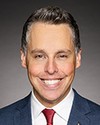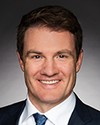Thank you.
Thank you, Mr. Chair.
Evidence of meeting #67 for Transport, Infrastructure and Communities in the 44th Parliament, 1st Session. (The original version is on Parliament’s site, as are the minutes.) The winning word was cory.
A recording is available from Parliament.
11:40 a.m.
Liberal

The Chair Liberal Peter Schiefke
Thank you very much, Mr. Badawey.
Mr. Barsalou‑Duval, you have the floor for six minutes.
11:40 a.m.
Bloc

Xavier Barsalou-Duval Bloc Pierre-Boucher—Les Patriotes—Verchères, QC
Thank you, Mr. Chair.
Let's come back to today's study, to the role McKinsey & Company played in the creation and beginnings of the Canada Infrastructure Bank.
I believe we need to go back a bit further and take note that after the 2015 election, the Trudeau Liberal government established the 14-member Economic Growth Advisory Council. Members included CEOs as well as academic and business leaders. It was this group that recommended that the Canada Infrastructure Bank be created. The same group was chaired by Dominic Barton, who was then the global managing partner at McKinsey & Company.
So it was this group, which was chaired by Dominic Barton and set up by the Prime Minister, that proposed that the infrastructure bank be created. At the time of its inception, that same bank contracted McKinsey to determine how it would operate. I, for one, find that peculiar. It's kind of like someone threw an idea out there, threw a hook in the water, then you took the bait and from then on they were going to make money off you.
Mr. Cory, don't you find that practice peculiar?
11:40 a.m.
Chief Executive Officer, Canada Infrastructure Bank
Thank you for the question.
Thank you.
I appreciate taking us back. I think that's the right context to start from. In fact, from my understanding, the concept of an Infrastructure Bank first appeared—and again, this is from the public record because I wasn't there at the time—even prior to the growth council. In the election of 2015, it was part of the campaign platform of the Liberal party, so this is an idea that existed.
Why is not surprising. Countries around the world have been exploring and are continuing to explore the idea of green banks or infrastructure banks, so this was not a new idea and was certainly on the official record even going into the election.
Now, as the member points out, I think the growth council—again, from the outside in, having not been part of it—certainly did make a number of recommendations, including endorsing the idea of an infrastructure bank, so it certainly built on.... It was not their idea, from what I can gather.
Now, to the member's question, I think what I can speak to is the hiring of McKinsey at the outset. It is important to note, so just picture the time. At that moment, the CIB had one acting employee who was a board member who had temporarily taken on the role of acting CIO, and their job was to get the place started.
They went out to get external help to do so, to write an investment policy, to develop risk management processes and to stand up the organization from scratch. From my review of the materials, they talked to a number of firms about doing that. I think McKinsey is not a surprising choice for that, given the range of their experience in infrastructure work and their global reach. I don't think there is a direct relationship between the growth council and the hiring of McKinsey.
11:40 a.m.
Bloc

Xavier Barsalou-Duval Bloc Pierre-Boucher—Les Patriotes—Verchères, QC
Thank you. Let me put it another way for you.
Suppose that I'm volunteering my services, as an accountant by profession trained at the time, to a board of directors or as a consultant to a business and, in that context, I ask for a system to be put in place that will allow me to award contracts to myself. Do you feel that would be entirely in order?
I'm asking because that's what I'm getting from your comments. In other words, Mr. Barton recommended that the Canada Infrastructure Bank be created, and then that same bank awarded him contracts.
I, for one, would not be comfortable in a situation like that, but you seem to be quite comfortable. I'm trying to figure out why.
11:45 a.m.
Chief Executive Officer, Canada Infrastructure Bank
Thank you.
No, I don't think I agree with the premise of the question. From my understanding, first of all—and Mr. Barton is someone you can ask that question of directly—I don't think he would claim that the Infrastructure Bank was “his idea”. As I said, it's in fact an idea that's existed for many years across multiple governments, in fact, and around the world. Yes, the growth council, of which Mr. Barton was a member, endorsed that idea.
Then the CIB got started, and one of the first things that the board of the CIB.... As I mentioned, there was one employee. There was also a board chair at the time, Ms. Fukakusa, and together they went out to the market to get help to stand up the organization.
I'm not saying that.... I don't see anything untoward in that.
11:45 a.m.
Bloc

Xavier Barsalou-Duval Bloc Pierre-Boucher—Les Patriotes—Verchères, QC
You may not have a problem with it because you yourself have navigated in an environment like that, the McKinsey firm, where sometimes the lines get blurred between public and private, and in terms of what is the McKinsey firm's responsibility and what is the government's responsibility.
Wouldn't the fact that you yourself held positions at McKinsey result in the lines being somewhat blurred and it being hard to distinguish between the two?
11:45 a.m.
Chief Executive Officer, Canada Infrastructure Bank
Thank you.
In my work at McKinsey, as the member mentioned, I was there for over a decade. I did work in infrastructure, minerals, mining and energy, and in the public sector. I worked for provinces, both Ontario and Saskatchewan. I did some consulting— even for the federal government. I can tell you that every project I ever did in my time at McKinsey, 15 years ago, was competitively bid in response to an RFP and was incredibly rigorous. The Government of Canada was a client, as were many provinces, and in all of that work, we bid competitively against others.
There was no relationship other than the expertise and global insights we bought that helped governments move forward.
11:45 a.m.
Liberal

The Chair Liberal Peter Schiefke
Thank you very much, Mr. Cory.
Thank you, Mr. Barsalou‑Duval.
Next we have Mr. Bachrach.
The floor is yours, Mr. Bachrach. You have six minutes.
11:45 a.m.
NDP

Taylor Bachrach NDP Skeena—Bulkley Valley, BC
Thank you very much, Mr. Chair.
Picking up on my colleague's commentary, for members of the public watching this meeting and listening to the testimony, I think it paints a certain picture. You have Dominic Barton, the managing director of McKinsey, who is intimately involved in the conception of the bank. The bank then hires his company to stand up the bank, and now we have a meeting with three of the five witnesses before us who were former McKinsey employees. It doesn't take much to see a certain picture there.
I want to take us down a different path.
In April 2001, the CIB signed an agreement in principle to invest $655 million in the Lake Erie Connector project, an underground transmission line that was going to deliver power from Ontario to Pennsylvania. ITC, the proponent of the project, is a massive company. In 2022, I think, it had $48 billion in assets. It's about twice the size of the Infrastructure Bank.
Why did a company this big need the bank's help in getting this project to go, Mr. Cory?
11:45 a.m.
Chief Executive Officer, Canada Infrastructure Bank
Thank you, Member.
Thank you, Chair for the question. I think it is an important one to discuss.
As I was describing in one of my earlier answers, fundamentally, what we're trying to do with our lending—and it is, as I said, all in the form of loans—is to make projects happen that are stuck. The Lake Erie Connector project—quite a classic example—has been on the books for more than a decade and hasn't been getting built. The reason is that it's a costly line and one with really uncertain trade volumes. It depends on what happens with the shutdown or extension of nuclear plants in Ontario. It depends on growth in the renewable sector in Ontario, and it certainly depends on what happens in the market it connects to in Pennsylvania and Ohio.
The project rates of return that we saw when we engaged with the company were well below their investment criteria, and they weren't moving forward with the project. So the idea of our making a loan to a project like that is to invest money to help them to manage the risk of the project so that it moves forward. To be clear, they were putting more money than we were into the project. They have lots of skin in the game, and they had lots of investment themselves, but our loan—and it is a loan—was designed to help improve the economics just enough so that they could move forward with the project.
11:50 a.m.
NDP

Taylor Bachrach NDP Skeena—Bulkley Valley, BC
Did the bank approach ITC, or did ITC approach the bank?
May 9th, 2023 / 11:50 a.m.
Chief Executive Officer, Canada Infrastructure Bank
I can't answer that question with certainty. That was right near the start of my time. My recollection is that they approached us first, but I would have to confirm that, if I may.
11:50 a.m.
NDP

Taylor Bachrach NDP Skeena—Bulkley Valley, BC
Mr. Corriveau, a spokesperson for the bank, was quoted as saying, “The private sector, in partnership with the CIB, can play a role in delivering important infrastructure. Without CIB acting as a catalyst for private sector investment, it could mean decades of waiting until the risk and economics are addressed.”
We're talking about de-risking a project that the private sector isn't willing to move forward with, and this is really interesting because one of the primary arguments that proponents of public-private partnerships make when arguing for P3s is that they transfer risk off the public sector and onto the private sector. Here's a case where we're talking about transferring risk from the private sector onto the public sector.
Under what circumstances should the public sector, Canadian taxpayers, Canadian citizens, assume risk that the private sector isn't willing to bear?
11:50 a.m.
Chief Executive Officer, Canada Infrastructure Bank
That's an excellent question. Thank you for that and the chance to respond.
The infrastructure deficit in our country is such that if we want to build long-run assets, new transmission across our country, new forms of clean energy across our country, such as my electric vehicle charging example that I gave to the member opposite earlier, those projects all face uncertainty or risk gaps that stop the private sector from moving forward today. As Canadians, I think the exact purpose of an infrastructure bank is to help bridge that gap—not to provide an outsized benefit to the private sector in any way, shape, or form, but to help bridge the gap.
To use the Lake Erie example, that project was estimated to create significant public benefit in the form of GHG emission reductions on both sides of the border. The benefit therefore of advancing the project without having to do it under a purely public model and by having some private sector money beside ours was to move it forward faster and to get that public benefit. Infrastructure is—
11:50 a.m.
NDP

Taylor Bachrach NDP Skeena—Bulkley Valley, BC
I think what you're saying, Mr. Cory, is that the public good here was the emissions reductions, and the assumption was that there was going to be a surplus of clean energy from Ontario that we could sell to the Americans.
What analysis did the bank base that assumption on? By many people's read, there is no surplus of clean energy from Ontario. In fact, the province is going to meet most of the future demand by burning gas, which is a fossil fuel. Where was this clean energy going to come from, and was there any data the bank used to come to the assumption that this project was going to reduce emissions?
11:50 a.m.
Chief Executive Officer, Canada Infrastructure Bank
There are two things I would say about that. One, we would always start—and did in the case of the Lake Erie Connector line—with a discussion with the electricity system operator. In that case, it was the IESO in Ontario. The IESO approved the project and signed a contract to move forward. There is a regulator in the energy markets in each of them that is actually thinking about supply and demand. The IESO deemed the project necessary, so that's—
11:50 a.m.
NDP

Taylor Bachrach NDP Skeena—Bulkley Valley, BC
Necessary versus reducing emissions are two different things.
11:50 a.m.
NDP
11:50 a.m.
Chief Executive Officer, Canada Infrastructure Bank
The IESO agreed with the analysis that it would reduce emissions, yes. To answer that part of the question—which goes back to Dr. Lewis' question from earlier—we hired an external adviser, a consulting firm, that understands power markets to do a modelling exercise for us of a whole range of scenarios of what might happen in both markets on both sides of the border.
11:50 a.m.
NDP
11:50 a.m.
Liberal

The Chair Liberal Peter Schiefke
I'm sorry. Unfortunately, we have no time left for that line of questioning. You do have another line of questioning coming up, Mr. Bachrach.
Thank you, Mr. Cory.
Dr. Lewis, the next round of questioning is to you. You have five minutes.
11:50 a.m.
Conservative

Leslyn Lewis Conservative Haldimand—Norfolk, ON
Thank you, Chair.
My question is for Counsel Duguay.
You had testified earlier about transparency in the procurement policy, so I'd like to ask you some questions about that.
We have some incongruent information that I touched upon in the Order Paper of May 9, 2021, provided to the government operations committee. In that response, as I stated, you listed five contracts back in March 2021 that the Infrastructure Bank engaged in with McKinsey. The bank's submission later to the government operations committee says there were three contracts. Indeed, the document provided to us by you includes five invoices, not three.
As a lawyer, I know that you have both a fiduciary obligation to the CIB and a professional obligation as a lawyer, so is it fair for me to conclude that since you provided five invoices and you listed five contracts on your Order Paper disclosure that there were actually five contracts? You could internally divide them up the way that they were, but these invoices and these payments and these descriptions show five different engagements. Is that correct?
11:55 a.m.
General Counsel and Corporate Secretary, Canada Infrastructure Bank
I disagree with the premise of the question. Let me explain why.
With respect to the responses to Order Paper questions, generally, when the CIB prepares responses to OPQs, we'll go back to our financial records to identify expenditures that are made to each of the consulting firms or any entity that is within the scope of an OPQ.
Those OPQs listed essentially five invoices, which may, as the member points out, lead you to reach the conclusion that we had entered into five separate contracts. Where I disagree with the question and where it's not the case is, when you go back to the record and when you go back to the source of the materials that were provided to OGGO and you look at the scope of work that was provided within each of the statements of work, in two cases, in particular in the second contract, where McKinsey was hired to provide advice on risk management practices, there were two scopes to that project.
The first scope, which was, I believe about $390,000, really related to foundational advice with respect to the governance of enterprise risk management. A lot of that work—